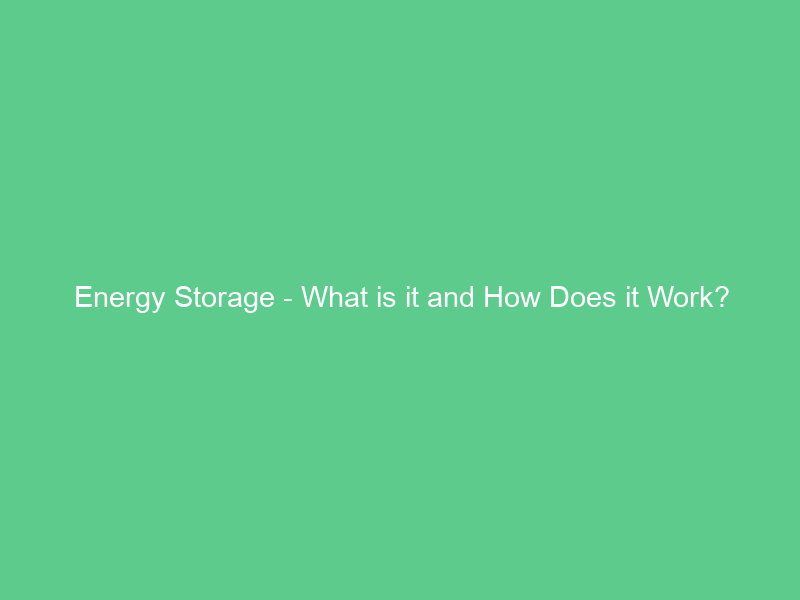Energy storage refers to the process of capturing and storing energy for later use. This can be accomplished via various means such as pumped hydro storage, batteries, flywheels, thermal ice storage or hydrogen storage components.
Energy storage technology can be utilized both on a large-scale in grid energy systems and small-scale residential solutions behind the meter, offering valuable services like frequency regulation and voltage regulation.
Rechargeable Batteries
Rechargeable batteries have become an indispensable part of our everyday lives, powering everything from portable electronic devices to electric vehicles. Rechargable batteries store chemical potential energy within an electrolyte and can be recharged over time, making them far more eco-friendly than disposable ones as they use less raw materials for manufacture and produce far fewer toxic byproducts when disposed of.
Rechargeable batteries do have some drawbacks. Rechargable batteries are susceptible to overcharging and undercharging, degrade over time, reducing capacity and leading to internal shorts or safety risks. Furthermore, exposure to extreme temperatures may cause them to discharge faster.
Researchers are developing new types of rechargeable batteries to address energy storage applications, with The Schwartz Group using advanced computational modeling and experimental methods to investigate recent discoveries including molten salt, redox flow, alkaline metal air and hydrogen gas batteries.
Flow Batteries
Most flow batteries utilize liquid electrolytes to store energy. This liquid electrolyte is stored outside the battery cells in tanks – making them significantly larger than lithium-ion batteries but providing lower per-unit costs as they expand compared with their lithium counterparts which become steadily more costly as their size increases.
Currently, hundreds of flow battery systems are in operation and most utilize vanadium liquid electrolytes, usually a mixture of vanadium sulfate and sulfuric acid. Vanadium stands out among its peers because it can take on and release electrons without degrading over time during charge-discharge cycles compared with other materials that degrade.
Larry Zulch of Invinity said flow batteries offer their best value when providing 10 to 36 hours of energy storage, ideal for matching wind supply to grid demand, according to Invinity CEO Larry Zulch. According to him, his company’s chromium-iron system can do this at 25%-30% lower cost than lithium-ion designs; and these flow batteries have already begun being deployed behind the meter at factories, campuses, and residences during premium rate periods when utilities offer voluntary energy curtailment programs.
Supercapacitors
Since wind turbines and solar panels do not match peak electricity consumption perfectly, power fluctuations arise that cause higher costs and increase costs overall. One solution would be integrating energy storage systems like supercapacitors into their system to buffer fluctuations in supply and consumption.
Supercapacitors (sometimes referred to as ultracapacitors) are hybrid energy storage devices which combine the qualities of batteries and capacitors for quick charge/discharge cycles and can store large amounts of power, making them suitable for quick energy boosts.
Supercapacitors typically consist of two porous electrodes containing electrolyte and separated by a separator, as well as powdered electrode materials mixed with binder and conductive additives to produce a slurry. This slurry is coated onto current collectors using slot-die coating technology for coating on current collectors.
This process enables slurry to be evenly applied onto current collectors, increasing its surface area and thus, its capacitance value. Next, the electrode slurry is mixed into electrolyte solution before being sealed in a container to form the supercapacitor.
Fuel Cells
Fuel cells are special kinds of power generators that produce both electricity and heat simultaneously. Hydrogen oxidation at its anode produces electrons which are then consumed by oxygen at its cathode to generate usable electrical current – all within a thin electrolyte layer between electrodes, which also holds its source fuel source.
Like batteries, fuel cells come in various sizes and shapes to suit different application requirements, but all operate by converting fuel into power with no emissions released into the atmosphere.
Fuel cells can be customized to fit almost every application imaginable, from small electronic devices like cellphones or digital watches, all the way up to large e-mobility vehicles. Fuel cells offer a more environmentally-friendly alternative than fossil-fuel powered equipment in stationary applications like data centers, retail and warehouse operations, microgrids and telecom hubs – and even utility-scale power generation sites.

